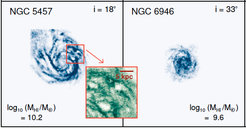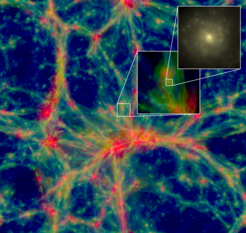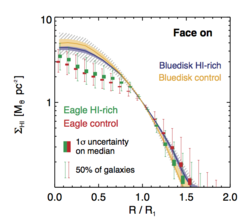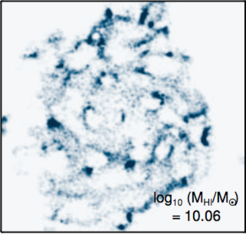The Distribution of Atomic Hydrogen in Simulated Galaxies

Observed distribution of atomic hydrogen (blue) in the nearby galaxy M74. Also shown are old stars (red) and UV radiation emitted by newborn stars (purple) - both of these are more strongly concentrated towards the galaxy’s centre than the atomic hydrogen. The green bar shows a length of 15 000 light years.
Atomic hydrogen (abbreviated as “H I”) is an important component of galaxies, it is believed to feed the dense ‘interstellar matter’ from which stars can form. Although invisible to optical telescopes, astronomers have been able to make ever more accurate observations of this gas component using radio telescopes: this has revealed, for instance, that galaxies with the same stellar mass can differ in their H I content by more than an order of magnitude. By combining several radio antennas into one `supertelescope’ with the aid of interferometry it has also become possible to create high resolution maps showing the distribution of atomic hydrogen within individual galaxies (for an example, see Fig. 1).
But despite this wealth of observational data, astronomers are still puzzled by the question of why some galaxies contain so much more H I than others, and especially why `normal’ and `H I-rich’ galaxies still appear to follow common relations, as shown recently by the MPA-led “Bluedisk” project (see monthly highlights May 2013 and March 2014). A fundamental problem is that galaxies only evolve over periods of many millions of years, so that it is impossible to directly observe how the H I reservoir is built up. Instead, astronomers have to try and answer this question with the aid of models and simulations.

Fig. 2:
Gas in the large EAGLE simulation. Blue represents “cold” gas (T < 30,000 K), green warm, and red the hottest gas with T > 300,000 K. The small insets zoom in towards a single galaxy, highlighting the huge dynamic range of the simulation.
An international collaboration has recently completed the “EAGLE” simulation of galaxies which matches observed galaxies in several properties such as their stellar mass and size with unprecedented accuracy (see Fig. 2). A research team led by MPA scientist Yannick Bahe has now studied how well these simulated galaxies agree with real ones in terms of their atomic hydrogen content: an important test for the simulation model, which also determines whether EAGLE can give trustworthy clues on the evolution of H I in real galaxies.
To make this comparison, the scientists first had to post-process the simulation and calculate how much of the hydrogen in each simulation particle is actually atomic, i.e. not ionised or molecular. Once this was done, the total mass of H I in over 2000 simulated galaxies could be computed and compared to observational data from the “GASS” project. The resulting match between simulation and data is extremely good: it represents a significant improvement compared to previous simulations and indicates that the models used in EAGLE provide a reasonable description of the physical processes involved in forming galaxies.

Fig. 3:
The surface density of atomic hydrogen, plotted against distance from the galaxy centre. Yellow and blue bands show data from the “Bluedisk” project, comparing galaxies with normal (yellow) and exceptionally high (blue) total atomic hydrogen content. Red and green circles show simulated galaxies from EAGLE in the same categories.
Motivated by this initial success, the scientists tested the EAGLE simulations in more detail by comparing not just the total mass of H I, but also its distribution within galaxies to observations. The above-mentioned “Bluedisk” project has shown that this distribution is surprisingly independent of the total mass of H I as long as the galaxies’ H I discs are scaled to a common size (so called “self-similarity”). For an accurate comparison, the team now ‘observed’ the EAGLE galaxies in the same way as was done in Bluedisk. As can be seen in Fig. 3, both agree surprisingly well: EAGLE reproduces both the self-similarity between ‘normal’ and ‘H I-rich’ galaxies (red and green symbols in Fig. 3) and the detailed shape of the surface density profile – at least in the outer parts of the simulated galaxies.
In the central regions, however, EAGLE galaxies typically contain not enough atomic hydrogen. To test this discrepancy further, the scientists inspected more than 2000 images of the simulated galaxies, which finally gave the crucial clue: many simulated galaxies contain ‘holes’ in their hydrogen discs that are much larger than what is seen in observations. Once all simulated galaxies showing these large holes were excluded, the density profiles matched observations almost perfectly even in the centre.

Fig. 4:
Synthetic image showing atomic hydrogen in a simulated galaxy, in analogy to Fig. 1. Clearly visible are a number of large holes in the hydrogen disc.
Why, now, do some EAGLE galaxies contain these large holes? The scientists have not yet found a definitive answer, but it is likely that the way in which supernova explosions are modelled in the simulation plays a major role. This critical part of galaxy formation is still causing headaches for simulators: to include them in galaxy simulations in a fully self-consistent fashion, the resolution of the simulations would need to go up by many orders of magnitude. This will be, regrettably, impossible for a long time to come – even the biggest supercomputers today are just not big enough (see also highlight August 2015). As a result, EAGLE has to resort to using a highly simplified model for the effects of such supernovae. Another simplified model has to be employed for the dense interstellar matter, because a resolution level that would allow a fully self-consistent treatment can also not yet be achieved in simulations of a representative portion of the Universe. Although these simplified models produce galaxies which are realistic in many ways – such as their size – they do leave a noticeable artefact in some of the simulated hydrogen discs: the large holes discovered by the researchers.
It is therefore an important challenge for astrophysicists to optimise both the simulation codes and the models in such a way that – in conjunction with continually more powerful supercomputers – a self-consistent treatment of the dense interstellar medium can be achieved. Combined with improved supernova models, these future simulations will, hopefully, produce galaxies that match the real Universe even better than EAGLE does. However, the current study also demonstrates that EAGLE can already give valuable insight into the evolution of atomic hydrogen in galaxies. In a follow-up project, the researchers will examine the formation of the simulated galaxies to find out how and why some of them got so much more hydrogen than others.















